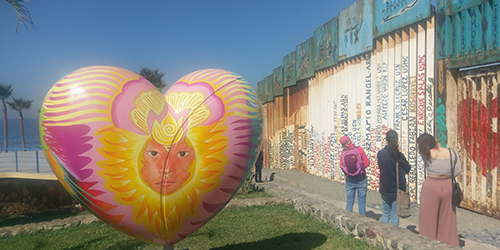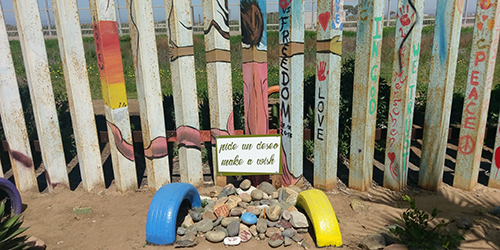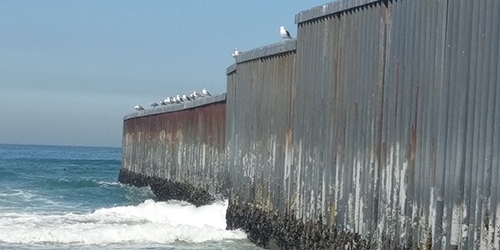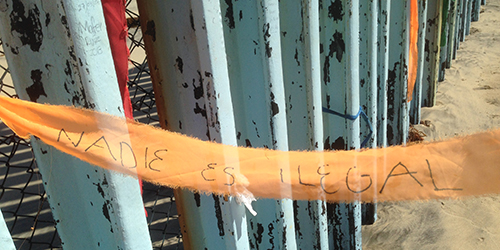The Wall That Already Exists at the U.S.-Mexican Border
While building a wall between the United States and Mexico is a dominant media topic, the border is already fortified in many places. Art and graffiti, reminiscent of the Berlin wall, is expressing the mourning of the dead and reminding the observers of freedom and peace in Tijuana – a walk at its most Western edge.
Tijuana is the most Western Mexican city at the border with the United States. It is a hub, an intersection at which various movements of people and goods go through; or are forced to go to. It is also a place in which mobility is transformed into immobility and people get stuck. Migrants and asylum seekers from the south of Mexico, Latin American countries, and especially Haiti come here in order to cross the border or file an application for asylum in the United States. People who are deported from the United States are stranded in Tijuana; often without any local connections or opportunities. Goods and drugs traveling into the United States are waiting to be transported from Tijuana. In 2017, 1 700 people were supposedly killed in connection to drug trafficking in Tijuana. “It’s dangerous to go there now”, “there may be resentments against Americans” is what we hear on the American side. We decide to hire a local driver to help us get to the different areas of this widespread city. Originally from Mexico City, Raphael moved to Tijuana for work.
Overall, the U.S.-Mexican border is 3 145 km long and around 1 million people cross this border at its various crossings every day in both directions. Around one third of its length is fortified with fences or other barriers. We cross the border from the U.S. side on a sunny Wednesday, passing the border posts as if they did not exist: no traffic jam, no passport control, just a smooth multilane road. On the way into the United States we see long lines of cars already in the morning.
Driving to the most Western part of the border by the Pacific Ocean, the friendship park, we drive along the border in Tijuana. Here, it is constructed of a fence made of metal sheets used by the army in the Iraq war, a strip for the border patrol and another fence. At the friendship park, the border becomes a wall-like fence made of metal pillars that leave enough space to see the other side.
Art, graffiti, and little vegetable gardens and flower beds remind us – each in their own way – of people who died while crossing and people who got deported such as U.S. army veterans. The messages convey freedom, peace, love, and respect. A little colorful spot asks those passing by to put down a stone and make a wish. It all seems like an attempt to add some humanity and life to this place. The strong fence reaches into the ocean in a way that the other side is always visible. Water flows through and seagulls take their seats on it, but humans can never fit through its gaps.
Children in their colorful swimsuits are playing cheerfully on the Tijuana beach, running into the waves or digging into the sand. Others are exercising on the little sport facility training ground that the Tijuana municipality set up by the beach. Tourists and locals are strolling on the board walk or taking selfies by the large Tijuana sign. If you ignored the long rusty border fence cutting the two neighboring countries and the mighty cameras surveilling every move around the fence, everything would seem normal.
Even though set in a very different environment, the situation brings back memories of the Berlin wall: the graffiti, the wishes, the fences and the border protection – and family separations.
The border around Tijuana is heavily secured so that people who cross undocumented have to choose other, more rural areas further east that are mostly desert or mountains, or they have to find a way of bribing the guards. In 2017, 340 000 people were arrested at the border and 412 people were reported dead in an attempt to cross in the desert or mountains, mostly because of heat, lack of water, cold temperatures or poisonous snakes. People who choose human traffickers, so called “coyotes”, to cross the border pay a lot of money and run a high risk of extortion and even torture.
In the wake of this debate and these different ways to deal with the border, it is sometimes forgotten that the border has not always been “set in stone” and is quite young in fact. The States north of the U.S. border were part of Mexico until the United States annexed them in a war that ended in 1848. Mexico lost around half of its territory, but Mexican people remained living in these regions and were granted U.S. citizenship. There has always been a lot of movement across this border and Mexican workers were called into the United States or deported to Mexico – always depending on the economic and political situation. From the early 20th century, border patrol and deportations to Mexico were practiced, but fences and fortifications as they exist today (mostly around cities) and as they are a major topic in the political discussion right now only started in the 1990s.
The question remains if this kind of border politics does not lead to people being stuck on both sides of the border – as also those who once made it to the United States cannot return without running the risk of giving up everything. Paradoxically, the border fortification thus may have even increased the settlement of Mexicans in the United States. They are afraid to cross back and not be able to return to the United States as they easily did previously.
On our way back to the United States, we walk across the border in order to save time. The university has briefed us which documents to take and after waiting in line for a short time, our passports and additional documents allow us to once again cross without much trouble – while at the same time families remain separated or people are starting a life-threatening trip through the desert.
Katrin Sontag, PostDoc, nccr – on the move, University of Basel and visiting fellow in 2018 at the Center for Comparative Immigration Studies, UC San Diego
Adi Hercowitz-Amir, Israel Institute Post-Doctoral Fellow, Center for Comparative Immigration Studies, UC San Diego
(All photos: Katrin Sontag and Adi Hercowitz-Amir)







